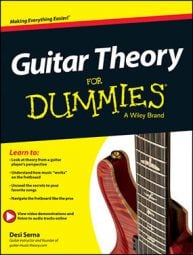After you add the notes of the V7 chord into the pentatonic pattern on the guitar, you’re just one note away from having complete natural and harmonic minor scales. In A minor, you only need to add in F. Here is A minor pentatonic, then A natural minor and A harmonic minor with the F note added.
Notice that the only difference between natural minor and harmonic minor is the 7th scale degree — G versus Gs.
![[Credit: Illustration courtesy of Desi Serna]](https://www.dummies.com/wp-content/uploads/417586.image0.jpg)
Guess what you have to do now? Practice, practice, practice! Well, you might like to consider it playing rather than practicing, but whatever you call it, be sure to work with these patterns for a while, taking time to alternate between the natural and harmonic minor scales. You can shift these patterns to new positions in order to play in other keys.
How you choose to play over the V7 chord in minor key chord progressions is a matter of preference. You can play the harmonic minor scale only over the V7 chord by using the raised 7th degree in place of the flat 7th. Or you can use the other notes of the V7 arpeggio and those of the complete harmonic minor scale in addition to the raised 7th.
You don’t always have to use the harmonic minor over a V7 chord in a minor key. You can continue to play the natural minor scale or just a minor pentatonic scale. If you go this route, be aware that the minor 7th scale degree will create a dissonance with one of the pitches in the V7 chord, but it’ll do so in a musically agreeable way.
For example, in the key of A minor, the minor 7th scale degree G sounds against the E7’s Gs. But it still works. In music theory terms, the sound you create is an E7s9 chord (see the nearby sidebar for details on this particular chord). If, however, you want to get the full effect of the harmonic minor sound, you need to use the raised 7th.

